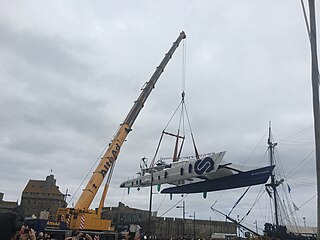
An electric boat is a powered watercraft driven by electric motors, which are powered by either on-board battery packs, solar panels or generators.

A compressed-air car is a compressed-air vehicle fueled by pressure vessels filled with compressed air. It is propelled by the release and expansion of the air within a motor adapted to compressed air. The car might be powered solely by air, or combined with other fuels such as gasoline, diesel, or an electric plant with regenerative braking.

A zero-emission vehicle, or ZEV, is a vehicle that does not emit exhaust gas or other pollutants from the onboard source of power. The California definition also adds that this includes under any and all possible operational modes and conditions. This is because under cold-start conditions for example, internal combustion engines tend to produce the maximum amount of pollutants. In a number of countries and states, transport is cited as the main source of greenhouse gases (GHG) and other pollutants. The desire to reduce this is thus politically strong.

A compressed-air vehicle (CAV) is a transport mechanism fueled by tanks of pressurized atmospheric gas and propelled by the release and expansion of the gas within a pneumatic motor.

Grid energy storage is a collection of methods used for energy storage on a large scale within an electrical power grid. Electrical energy is stored during times when electricity is plentiful and inexpensive or when demand is low, and later returned to the grid when demand is high, and electricity prices tend to be higher.
Shore power or shore supply is the provision of shoreside electrical power to a ship at berth while its main and auxiliary engines are shut down. While the term denotes shore as opposed to off-shore, it is sometimes applied to aircraft or land-based vehicles, which may plug into grid power when parked for idle reduction.

Microgeneration is the small-scale production of heat or electric power from a "low carbon source," as an alternative or supplement to traditional centralized grid-connected power.
Suzlon Energy Limited is an Indian multinational wind turbine manufacturer based in Pune, India. It was formerly ranked by MAKE as the world's fifth largest wind turbine supplier.

Hybrid power are combinations between different technologies to produce power.

An alternative fuel vehicle is a motor vehicle that runs on alternative fuel rather than traditional petroleum fuels. The term also refers to any technology powering an engine that does not solely involve petroleum. Because of a combination of factors, such as environmental concerns, high oil-prices and the potential for peak oil, development of cleaner alternative fuels and advanced power systems for vehicles has become a high priority for many governments and vehicle manufacturers around the world.

Marine propulsion is the mechanism or system used to generate thrust to move a watercraft through water. While paddles and sails are still used on some smaller boats, most modern ships are propelled by mechanical systems consisting of an electric motor or internal combustion engine driving a propeller, or less frequently, in pump-jets, an impeller. Marine engineering is the discipline concerned with the engineering design process of marine propulsion systems.

A gas-fired power plant or gas-fired power station or natural gas power plant is a thermal power station which burns natural gas to generate electricity. Natural gas power stations generate almost a quarter of world electricity and a significant part of global greenhouse gas emissions and thus climate change. However they can provide seasonal dispatchable generation to balance variable renewable energy where hydropower or interconnectors are not available.
The canal boat Ross Barlow is a hybrid hydrogen narrowboat, power-assisted by an electric motor whose electricity is supplied by a fuel cell or a battery. It debuted on 21 September 2007.
The 42' sailboat known as the XV/1 was intended to demonstrate Haveblue LLC's patented technology for the production, storage, and use of hydrogen on board a marine vessel. The anticipated range was to be a radius of ~300 nautical miles at 8 knots on a full tank.
A hydrogen ship is a hydrogen fueled ship, power-assisted by an electric motor that gets its electricity from a fuel cell. Or uses hydrogen fuel in an internal combustion engine.
Hornblower Cruises & Events NOW City Experiences is a San Francisco-based charter yacht, dining cruise and ferry service company.
Hybrid ferries are ferries that combine multiple sources of power, resulting in reductions in fossil fuel consumption, carbon emissions and other pollutants.

"Sustainability," was defined as “development which implies meeting the needs of the present without compromising the ability of future generations to meet their own needs”as defined by the 1983 Brundtland Commission. As sustainability gains support and momentum worldwide, universities across the United States have expanded initiatives towards more sustainable campuses, commitments, academic offerings, and student engagement.
Atlantic County Utilities Authority (ACUA) is a public agency in Atlantic County, New Jersey, that is responsible for enhancing quality of life through the protection of waters and lands from pollution by providing responsible waste management services.

Energy Observer, launched in April 2017, is the first vessel autonomous in energy thanks to a mix of renewable energy and renewable hydrogen produced on board. Developed in collaboration with engineers from the CEA-LITEN the boat will test and prove the efficiency of a full production chain that relies on the coupling of different renewable energies. Following its launch, the boat left in the Spring 2017 for a world tour lasting 6 years in order to optimize its technologies and lead an expedition that will serve durable solutions for energy transition. The boat was nominated first French ambassador of the Sustainable Development Goals by the French Ministry for an ecological and solidary transition.













